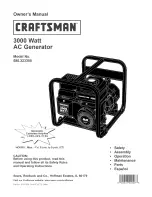
6-6
Chapter 6 COOLANT
Importance of LLC
Today's trend is toward smaller and lighter engines
offering greater output, lower fuel consumption and
lower exhaust emission levels.
Conditions to which engine coolant is subjected,
therefore, are becoming severer due to longer operat-
ing hours, higher coolant temperature and higher cool-
ant circulating speed.
Many different materials such as steel, aluminum,
copper, solder and rubber are used in the cooling sys-
tem, and they are also subjected to the severe condi-
tions described above. Those materials have different
ionization characteristics, and this difference acceler-
ates corrosion through the medium of engine coolant.
To prevent such a problem, the use of LLC that con-
tained the additive to prevent rust is very important.
Characteristics of LLC
additive and important
notes
LLC contains several chemicals in such proportions
as to produce chemical reactions that suppress corro-
sion (ionization) of engine parts in contact with the
coolant. LLC loses its effectiveness by hours of use as
well as lapse of time.
Moreover, if the chemicals in LLC are not maintained,
certain chemicals in the LLC become rapidly used up
and result in dissolution of metals instead of protecting
metals from corrosion. Consequently, other corrosion
preventing chemicals react with dissolving metals and
accelerate corrosion. This condition generates more
severe corrosion than when plain soft water is used.
This is a typical problem caused by the use of inap-
propriate LLC.
Examples of abnormali-
ties caused by LLC (amine
type)
Pitting of iron parts
Amines are generally effective in suppressing the rust-
ing of ferrous metals, but they are said to cause prob-
lems for copper parts.
Dissolved copper (copper corrosion) in the cooling
system deposits on iron parts and the copper deposits
cause corrosion and then pitting on iron parts that
have a high ionization characteristics due to galvanic
or local-cell action.
Corrosion of aluminum parts
Silicate is highly effective in protecting aluminum
against rusting. However, it is unstable in a solution in
which the pH is 9 or lower, and can turn to gel and pre-
cipitate in the solution. For this reason, the pH is usu-
ally specified to be about 10 to ensure a high alkaline
level.
This means, after silicate is used up, the high alkalinity
causes chemical attacks on aluminum. To prevent this
problem, proper maintenance of the coolant is
required. For case example, rapid wear of mechanical
seals in the water pump due to secondary effects of
silicate gel formed. Corrosion of aluminum parts after
silicate is consumed.
Pitting and clogging of the radi-
ator
When LLC deteriorates or when its concentration in
the coolant is too low, the anti-corrosion performance
of LLC lowers and results in the corrosion of met-
als.Brass and solder tend to corrode faster than other
metals, and corrosion of these metals is said to cause
water leakage and clogs. Example: Holes and clogs in
radiator
153/242
Содержание R33C3
Страница 2: ......
Страница 61: ...The following diagram shows the structure of the main menu and how to go to each parameter 59 242 ...
Страница 94: ...92 242 ...
Страница 95: ...10 Appendix 10 1 Appendix A Engine user and maintenance manual 93 242 ...
Страница 96: ...94 242 ...
Страница 98: ...96 242 ...
Страница 115: ...113 242 ...
Страница 135: ...133 242 ...
Страница 145: ...143 242 ...
Страница 179: ...177 242 ...
Страница 191: ...July 2009 Pub No 99610 29120 OPERATION MAINTENANCE MANUAL 189 242 ...
Страница 192: ...Printed in Japan Pub No 99610 29120 190 242 ...
Страница 193: ...10 2 Appendix B Alternator user and maintenance manual 191 242 ...
Страница 194: ...192 242 ...
Страница 196: ...194 242 ...
Страница 227: ...Installation and maintenance R250 A V R 4067 en 2009 05 b LEROY SOMER 11 225 242 ...
Страница 242: ...14 LEROY SOMER 2010 11 f Installation and maintenance R438 NOTES 3971 en 240 242 ...
Страница 243: ...LEROY SOMER 15 2010 11 f Installation and maintenance R438 NOTES 3971 en 241 242 ...
















































